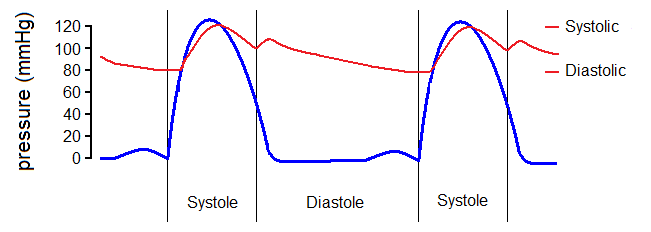The key difference between systole and diastole is that systole refers to the contraction of atria and ventricles, forcing blood to enter into the aorta and pulmonary trunk, while diastole refers to the relaxation of atria and ventricles, allowing the filling of heart chambers with blood.
The cardiac cycle is the time period that begins with the contraction of the atria and ends with ventricular relaxation. This includes systole and diastole of the atria and systole and diastole of ventricles. Usually, with a heart rate of 75 beats per minute, one cardiac cycle takes 0.8 seconds to complete. During the cardiac cycle, two atria contract at the same time. When they relax, two ventricles start to contract simultaneously. Systole refers to the contraction phase, while diastole refers to the relaxation phase.
CONTENTS
1. Overview and Key Difference
2. What is Systole
3. What is Diastole
4. Similarities Between Systole and Diastole
5. Side by Side Comparison – Systole vs Diastole in Tabular Form
6. Summary
What is Systole?
Systole is the contraction phase of atria and ventricles. It occurs due to the spreading of excitation across the heart. Atrial systole explains the action of atria contraction while ventricle systole explains that of ventricle contraction.

Figure 01: Diastole and Systole
During the atrial systole, the blood in the atria flows into ventricles through atrioventricular valves. Atrial systole normally lasts for 0.1 seconds. At the time of atrial systole, the ventricles are in the diastole. The duration of ventricular systole is about 0.3 second. During the ventricular systole, the pressure increases inside the ventricles. Hence, it closes the atrioventricular valves and opens the semilunar valves, allowing blood to enter the pulmonary trunk and ascending aorta in order to carry it away from the heart.
What is Diastole?
Diastole is the relaxation phase of the atria and ventricles. It occurs after the subsequent repolarization of the cardiac muscles.

Figure 02: Cardiac Cycle Pressure
Diastole occurs followed by the atrial and ventricular systole and remains for 0.4 seconds. During the ventricular diastole, atria are in diastole and get blood through the venae cavae and pulmonary veins. 70% of the blood enters the ventricles during the diastole while the remaining 30% enters during the atrial systole.
What are the Similarities Between Systole and Diastole?
- Systole and diastole are two events of the cardiac cycle.
- Diastole is followed by the systole.
- Both play a key role in blood circulation.
What is the Difference Between Systole and Diastole?
Systole is the contraction phase of atria and ventricle, whereas diastole is their relaxation phase. Thus, this is the key difference between systole and diastole. Moreover, systole occurs due to the spread of excitations, whereas relaxation occurs due to the subsequent repolarization of the cardiac muscle. This is also a difference between systole and diastole.
Generally, aria systole lasts for about 0.1 seconds while atrial diastole lasts for the remaining 0.7 seconds. Ventricular systole lasts for about 0.3 seconds while ventricular diastole lasts for the remaining 0.5 seconds. Therefore, this is another difference between systole and diastole.

Summary – Systole vs Diastole
The cardiac cycle has two main stages as systole and diastole. Systole is the contraction phase, while diastole is the relaxation phase. Thus, this is the key difference between systole and diastole. Systole occurs via two main events: atrial systole and ventricular systole. Similarly, diastole occurs via two events: atrial diastole and ventricular diastole. Normal systolic pressure is about 120 mmHg while normal diastolic pressure is about 80 mmHg. During the systole, blood pushes from heart chambers to the aorta and pulmonary artery. During the diastole, heart chambers fill with blood from vena cava and pulmonary veins.
Reference:
1. Silva, Joana Cavaco. “Diastole vs. Systole: What Is the Difference?” Medical News Today, MediLexicon International, Available here.
2. “Anatomy and Physiology II.” Cardiac Cycle | Anatomy and Physiology II, Available here.
Image Courtesy:
1. “Human healthy pumping heart en” By Mariana Ruiz Villarreal (LadyofHats) – Own work (Public Domain) via Commons Wikimedia
2. “Cardiac cycle pressure only” By Cardiac_Cycle_Left_Ventricle.PNG: DestinyQxderivative work: Physchim62 (talk) – Cardiac_Cycle_Left_Ventricle.PNG (CC BY-SA 2.5) via Commons Wikimedia
ncG1vNJzZmivp6x7pbXFn5yrnZ6YsqOx07CcnqZemLyue8OinZ%2Bdopq7pLGMm5ytr5Wau26%2F2KyrqKSVYq6vsIydoJqrpKS5pns%3D